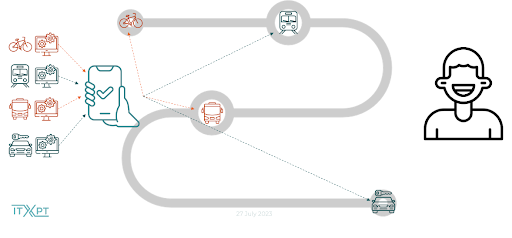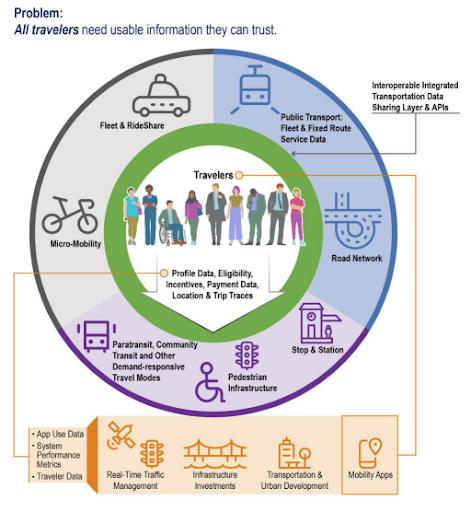Approaches to Mobility Interoperability: July 2023 MIC Quarterly Meeting Recap
By Shared-Use Mobility Center
Aug 8, 2023

Introduction
The Mobility Innovation Collaborative (MIC) is a Shared-Use Mobility Center (SUMC) program run in partnership with the Federal Transit Administration (FTA) to provide technical assistance to over 40 FTA grantees and share lessons learned from innovative projects from around the country. Since July 2020, the MIC team has organized meetings each quarter to explore in-depth issues, trends, and developments in the mobility industry. As the MIC program winds down, SUMC hosted the final MIC Quarterly Meeting on July 27, 2023. Building upon the lessons from the MIC workgroup that created the Path to Mobility Interoperability, this MIC quarterly meeting included a technical session to expand the research and conversations on mobility data interoperability. SUMC hosted as guest speakers: Tu-Tho Thai, Manager of Projects and Partnerships at the Europe-based Information Technology for Public Transport (ITxPT), and Anat Caspi, Director of the Taskar Center for Accessible Technology (TCAT) at the University of Washington. The speakers presented on how their organizations are pursuing open source, open source, and interoperable transportation technologies.
The meeting also included a session to celebrate the achievements and impacts of the MIC Program and the MIC grantees’ innovative projects. Gwo-Wei Torng, Director of the Federal Transit Administration’s Office of Mobility Innovation, reflected on the importance of mobility innovation projects that support the FTA’s visions for complete trips and multimodal mobility services, as well as on the value that the MIC demonstration projects have brought to their local communities and the transit industry. The meeting closed with a round of presentations where MIC grantees shared lessons learned from their projects and collectively celebrated their successes.
About the technical presentations
ITxPT (Information Technology for Public Transport) is a non-profit organization based in Europe which develops IT architecture standards with the aim of integrating different systems and building interoperability for public transit. ITxPT is a membership organization with more than 160 members in 28 countries, and has a global focus. Tu-Tho Thai showcased ITxPT’s work in producing standards and specifications for mobility systems, explained how transportation is more efficient when all components of the systems are interoperable and integrated from hardware to back-office systems, and relayed the importance of having a quality label from a trusted third party to ensure compliance with a standard. ITxPT’s data specification is fully open source and available on the ITxPT wiki. Learn more about ITxPT’s work through their 2022 Activity Report.

The Taskar Center for Accessible Technology (TCAT), within the Paul G. Allen School of Computer Science at the University of Washington, develops and deploys open-source, universally accessible technologies. TCAT is focused on participatory and inclusive design practices to improve quality of life, particularly for individuals with disabilities, including improving access to transportation. In her presentation, Anat Caspi spoke about the University of Washington project designed to advance mobility justice through open data about sidewalks, transit paths, and on-demand transit services. The project aims to create, modify, maintain, and improve data standards and data integration tools for more effective data sharing.

Key Takeaways
Open data, open platforms
Mobility data interoperability is fundamentally the ability for mobility technologies to freely exchange data with each other. Not only does an interoperable system need data standardization so that it can be widely understood, but it also requires open platforms with the infrastructure to store and analyze this data. Anat Caspi highlighted how some platforms are using open data standards for the benefit of travelers, including TCAT’s AccessMap, which can provide personalized and customized trip planning. Another TCAT platform is the Open Sidewalks project, which works to collect, organize, and standardize pedestrian network data. Along with open, accessible, and interoperable data, having the open tooling ecosystem to handle that data so that it is easier for producers and consumers, and at the same time beneficial to the traveler population, is equally valuable.
Breaking down silos can be a challenge, but it is necessary
Data interoperability requires coordination and cooperation between all entities involved. In many cases, this necessitates overcoming the major barrier that some partners, particularly in the private sector, might be reluctant to openly share their data. During the technical session, presenters discussed some strategies to build partnerships and break down silos to share resources. It can be difficult to change peoples’ minds about how they use data, but ongoing conversations in the industry have made it easier to make the case to private operators and original equipment manufacturers (OEMs) for more open data sharing policies. For example, as the transportation industry moves to favor retrofitting and repairing vehicles rather than acquiring new ones, OEMs have started recognizing that data interoperability helps to ensure better maintenance practices and more efficient fleets. Thus, the more data sharing becomes widespread, the less apprehensive operators and OEMs become.
Having patience and making sure all stakeholders recognize the value of the initiative is a key to success. Private operators and OEMs can benefit from proprietary work in some ways, but large-scale growth is not viable without inter-organizational cooperation – it is much easier to form partnerships and move forward together as an industry.
Strong policy helps get governmental buy-in
Government entities play an important role in facilitating data coordination, and when policy supports mobility data interoperability, it helps ensure government buy-in. Clear government mandates make it easier to achieve data sharing goals or projects that involve data sharing. Sometimes, those mandates and policy decisions stem from large events. For example, as Paris, France prepares for the 2024 Olympic and Paralympic games, various government entities involved in the planning process recognize the importance of data sharing for such large coordinated events, and are therefore more willing to push for open data policies and solutions than without that incentive.
Make sure to have staff who can understand and navigate legislation
As important as it is to understand the software, hardware, and other technological aspects behind integrated systems, it is equally as important to understand the legislative landscape. To make sure the interoperability model works and works well, having a team with a good understanding of existing regulations can help navigate what is possible and what is not, as well as to lead the proposal to change policies and legislation to enable or require interoperability.
Much of the hesitation surrounding data interoperability has to do with liability and maintaining data privacy. Some of this responsibility falls on the data infrastructure, but there are also legal implications for addressing data privacy. Determining how stakeholders can access and share data, or what specific pieces of data stakeholders can access is an important consideration for an interoperable system, and may vary depending on where that system is located.
Be accommodating to local needs
Data needs differ from community to community, so it is important for data schemas to be flexible enough to accommodate local concerns and priorities. Local communities know their biggest pain points and desires, and being able to attune to those needs is key. Some community partners may also lack the skill sets to formulate and analyze data sets on their own, so having tools and making them available to allow local community partners to access that data on an ongoing basis is key to building an interoperability model.
Conclusion
Mobility interoperability is a major step in understanding transportation needs, enhancing transportation operations, and improving rider experience. Fundamental to this process are the efforts of organizations like ITxPT and TCAT that work towards data standardization, open architecture, universal design, and system integration. As the shared mobility industry grows, initiatives to promote data interoperability are increasingly important for a modern and connected mobility ecosystem.
For more information on data interoperability and integrated transportation, check out SUMC’s case study on The Role of Data Specifications in Creating an Interoperable Transportation System and Mobility Interoperability Logic Model.
Revised June 2025.